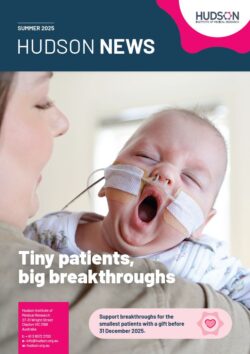Areas of interest
Infertility
Testicular cancer
Research group
Testis Development and Male Germ Cell Biology
Biography
Penny Whiley Ph.D. is a Postdoctoral Scientist working with Professor Kate Loveland in the Testis Development and Male Germ Cell Biology lab. She specialises in laboratory-based discovery research in the field of male reproductive health, with her current projects focusing on understanding how nuclear import factors, named ‘importins’, and the growth factor activin A support spermatogenesis throughout testis development.
In 2023, Dr Whiley was awarded a Ph.D. from Monash University, for her thesis entitled ‘The roles of activin A and Ipo5 in spermatogonial stem cell biology’. Dr Whiley has won a range of awards for her work, including the DGA Lecture Prize in the experimental field from the German Andrology Society, the Anna Steinberger Top Trainee Merit Award from the American Society of Andrology and a Monash University Faculty of Medicine 3-Minute Thesis competition.
Fast facts with Dr Penny Whiley
Q: What is a medical research scientist?
A: As a medical research scientist, my work revolves around conducting scientific investigations to better understand the causes of disease and advance medical knowledge. My role is purely lab based, so I design experiments, analyse data/results, and share discoveries through publications.
Q: So do you see patients?
A: No, having a PhD doesn’t make me a clinician or medical doctor. My expertise in laboratory-based research, so I don’t treat patients or prescribe medication—my daily tools are test tubes, microscopes and data sets!
Q: What do you love about research and discovery science?
A: What excites me most is unravelling the mysteries of how the body works—it’s like solving an intricate puzzle, and every piece brings us a bit closer to understanding the bigger picture. There’s nothing quite like that “aha!” moment in science.
Q: How does your work contribute to medical research?
A: My research focuses on exploring how different cells in the body function. By expanding our understanding, I hope to inform the development of future medical treatments and interventions that are backed by solid evidence and scientific rigour.
Q: What skills are important when working in a research or laboratory environment?
A: Being organised and methodical is absolutely essential. Planning, attention to detail, and a dash of creativity go a long way in the lab—and often lead to those breakthrough discoveries!
Q: What is your average day like?
A: My mornings are usually spent hands-on in the lab, working on experiments and gathering data. The afternoons are for diving into analysis, reading up on the latest scientific developments, and plotting my next exciting experiment. No two days are ever quite the same!
Q: What is your favourite lab technique?
A: Without a doubt, immunofluorescence and confocal microscopy top the list. These techniques produce stunning images and offer the incredible experience of seeing tissues in remarkable detail. It’s both beautiful and informative—science meets art!
Publication highlights

Hutchison JC, Trim PJ, Whiley PAF, Handeslman D, Snel MF, Groome NP, Hedger MP, Loveland KL (2025) Impact of excess activin A on the lipids, metabolites, and steroids of adult mouse reproductive organs. Endocrinology. Accepted for publication 10 April 2025. Doi.org/10.1210/endocr/bqaf054.
Whiley PAF, Nathaniel B, Stanton PG, Hobbs RM, Loveland KL (2023) Spermatogonial fate in mice with increased activin A bioactivity and testicular somatic cell tumours. Front Cell Dev Biol. Jul 26;11:1237273.
Whiley PAF*, Luu MCM*, O’Donnell L, Handelsman DJ, Loveland KL (2023) Testis exposure to elevated activin A in utero affects somatic and germ cells and alters steroid levels, mimicking phthalate exposure in mice. Front Endocrinol (Lausanne). Sep 1;14:1234712. (*co-first author)
Moody SC, Whiley PAF, Western PS, Loveland KL (2022) The impact of Activin A on fetal gonocytes: Chronic versus acute exposure outcomes. Front Endocrinol (Lausanne). May 31;13:896747.
O’Donnell L, Whiley PAF, Loveland KL (2022) Activin A and sertoli cells: Key to fetal testis steroidogenesis. Front Endocrinol (Lausanne). May 24;13:898876.
Nathaniel B, Whiley PAF, Miyamoto Y, Loveland KL (2022) Importins: Diverse roles in male fertility. Semin Cell Dev Biol. Jan;121:82-98.
Whiley PAF, O’Donnell L, Moody SC, Handelsman DJ, Young JC, Richards EA, Almstrup K, Western PS, Loveland KL (2020) Activin A determines steroid levels and composition in the fetal testis. Endocrinology. Jul 1;161(7):bqaa058.
Miyamoto Y, Sasaki M, Miyata H, Monobe Y, Nagai M, Otani M, Whiley PAF, Morohoshi A, Oki S, Matsuda J, Akagi KI, Adachi J, Okabe M, Ikawa M, Yoneda Y, Loveland KL, Oka M (2020) Genetic loss of importin α4 causes abnormal sperm morphology and impacts on male fertility in mouse. FASEB J. Dec;34(12):16224-16242.
Miyamoto Y, Whiley PAF, Goh HY, Wong C, Higgins G, Tachibana T, McMenamin PG, Mayne L, Loveland KL (2018) The STK35 locus contributes to normal gametogenesis and encodes a IncRNA responsive to oxidative stress. Biol Open. Aug 6;7(8):bio032631.
Miyamoto Y, Baker MA, Whiley PAF, Arjomand A, Ludeman J, Wong C, Jans DA, Loveland KL (2012) Towards delineation of a developmental α-importome in the mammalian male germline. Biochim Biophys Acta. Mar;1833(3):731-42.
Whiley PAF, Miyamoto Y, McLachlan RI, Jans DA, Loveland KL (2011) Changing subcellular localization of nuclear transport factors during human spermatogenesis. Int J Androl Apr;35(2):158-69.
Ly-Huynh JD, Lieu KG, Major AT, Whiley PAF, Holt JE, Loveland KL, Jans DA (2022) Importin alpha2-interacting proteins with nuclear roles during mammalian spermatogenesis. Biol Reprod. Dec;85(6):1191-202.
Major AT, Whiley PAF, Loveland KL (2011) Expression of nucleocytoplasmic transport machinery: clues to regulation of spermatogenic development. Biochim Biophys Acta. Sep;1813(9):1668-88.
Itman C, Wong C, Whiley PA, Fernando D, Loveland KL (2022) TGFβ superfamily signaling regulators are differentially expressed in the developing and adult mouse testis. Spermatogenesis. Jan;1(1):63-72.
Huynh JD, Efthymiadis A, Whiley PAF, Richards E, Lescesen H, Meier I, Matera GA, Loveland KL, Jans DA (2010) Importin α2 mediates subnuclear targeting of the cajal body component Coilin; A key role in spermatogenesis? Reprod Fert Dev.



